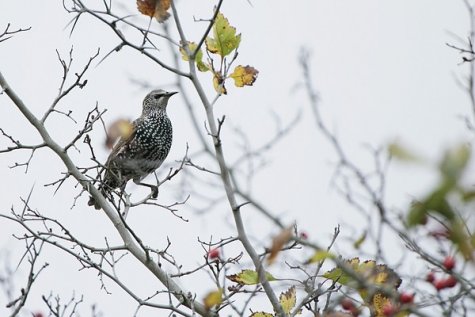Note the passing starlings
Photo: Arne Ader
Translation: Liis
Starling in hawthorn
| Starling |
Kuldnokk
|
Sturnus vulgaris |
In October migrating starlings from northern and north-eastern areas pass through Estonia. Mostly they migrate by day. The birds set out on their autumn migration quite early and move in short stages with frequent stops, depending on available food, weather and many other things.
The dull winter plumage of starlings shows in Arne’s photo; the number of light flecks has grown and the size has increased. Noticeable differences between the male and female birds are the area surrounding the eyes and the colour of the beak. The iris of the female bird is circled by a pale ring, it is uniformly dark for the male bird. The base ot the female bird’s beak is pinkish or yellowish-white, the male’s is blue-tinged.
Try to determine the sex of the starling in the photo, as an exercise!
The lifetime of fast flyers isn’t usually long, and the starlings, along with the swallows, are among the fastest ones – their flying speed may be up to 75 km/h - and their average age stops at a few years.
The main wintering areas of our starlings are the Netherlands, Belgium, Britain, Ireland ... Each year a small number of starlings stay in Estonia for winter.









